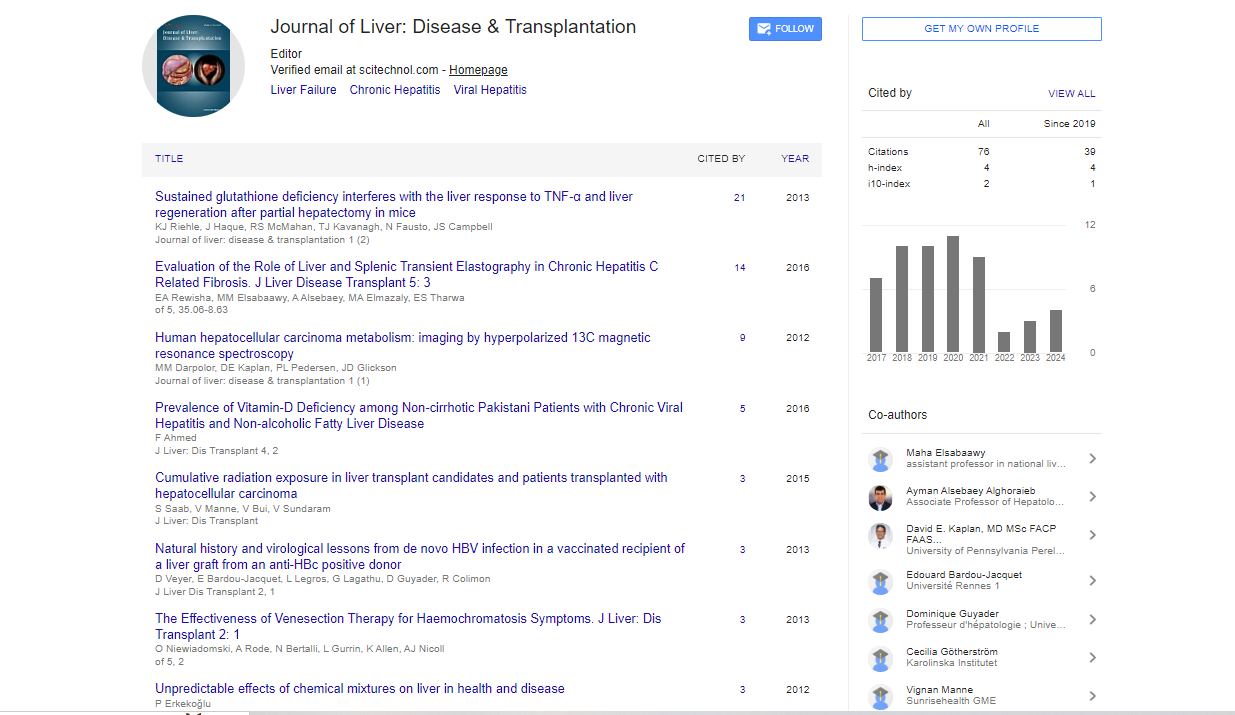Opinion Article, J Liver Disease Transplant Vol: 12 Issue: 4
Disorders and Surgical Interventions of Bile Duct
Guna Zoho*
1Department of Laboratory Medicine, Shinshu University School of Medicine, Matsumoto, Japan
*Corresponding Author: Guna Zoho,
Department of Laboratory Medicine,
Shinshu University School of Medicine, Matsumoto, Japan
E-mail: zohog676@ac.jp
Received date: 20 November, 2023, Manuscript No. JLDT-23-123671;
Editor assigned date: 22 November, 2023, Pre QC No. JLDT-23-123671 (PQ);
Reviewed date: 06 December, 2023, QC No. JLDT-23-123671;
Revised date: 13 December, 2023, Manuscript No. JLDT-23-123671 (R);
Published date: 20 December, 2023, DOI: 10.36648/2325-9612.100250
Citation: Zoho G (2023) Disorders and Surgical Interventions of Bile Duct. J Liver Disease Transplant 12:4.
Description
The bile duct is a vital component of the digestive system, playing a crucial role in the processing and transportation of bile. This specialized duct is essential for the digestion of fats and the overall health of the liver and the gastrointestinal system. The bile duct is a complex network of tubes and vessels that facilitate the flow of bile from the liver to the small intestine. Understanding its anatomy is fundamental to comprehending its functions. The bile duct consists of various components, including the hepatic ducts, common bile duct, and pancreatic duct. The hepatic ducts emerge from the liver, collecting bile produced by hepatocytes (liver cells). These ducts join to form the common hepatic duct, which then merges with the cystic duct (coming from the gallbladder) to create the common bile duct. The common bile duct further joins the pancreatic duct before entering the duodenum. The gallbladder acts as a reservoir for bile. Between meals, bile is stored in the gallbladder, and during digestion, it is released into the common bile duct to aid in the breakdown and absorption of fats.
The primary functions of the bile duct are associated with the secretion, transportation, and regulation of bile, a digestive fluid essential for fat metabolism. The liver produces bile continuously, a yellow-green fluid containing water, bile salts, bilirubin, cholesterol, and electrolytes. Bile salts, in particular, play a critical role in emulsifying fats, breaking them into smaller particles for easier digestion. Bile is stored in the gallbladder, which contracts to release bile into the common bile duct when stimulated by the hormone cholecystokinin during food digestion. Bile aids in the digestion and absorption of fats. Bile salts emulsify fat molecules, increasing their surface area and facilitating the action of pancreatic lipase, an enzyme that breaks down fats into absorbable components. Several disorders can affect the bile duct, leading to disruptions in bile flow, impaired digestion, and potential complications. Bile Duct Obstruction Occurs when the flow of bile is blocked, either within the ducts or externally. Causes include gallstones, inflammation, tumors, or strictures. Biliary Atresia is a congenital condition where the bile ducts are abnormally narrow or absent, leading to bile flow obstruction. It is a significant cause of neonatal jaundice. Primary Biliary Cholangitis (PBC) is an autoimmune disease that targets the small bile ducts within the liver, leading to inflammation and scarring. Cholangitis is the Inflammation of the bile ducts, often caused by bacterial infections. Symptoms include fever, jaundice, and abdominal pain.
Diagnostic approaches
Understanding the anatomy and functions of the bile duct is crucial for diagnosing and managing disorders related to its structure and function. Non-invasive techniques such as ultrasound, Magnetic Resonance Imaging (MRI), and Computed Tomography (CT) scans help visualize the structure of the bile duct and detect abnormalities. Endoscopic Retrograde Cholangio Pancreatography (ERCP) is a procedure where a flexible tube with a camera is inserted through the mouth to the duodenum. Contrast material is injected into the bile ducts to highlight their structure on X-rays. Blood tests measuring liver enzymes and bilirubin levels help assess the overall health of the liver and identify abnormalities in bile flow. For certain bile duct disorders or complications, surgical interventions may be necessary. In cases of gallstones causing bile duct obstruction, the gallbladder may be removed to improve bile flow. Surgical procedures may be performed to repair damaged bile ducts, especially in cases of strictures or injuries. In severe cases of bile duct disorders, a liver transplant may be considered to replace a damaged liver with a healthy one.
Conclusion
In conclusion, the bile duct is an integral part of the digestive system, contributing significantly to the breakdown and absorption of fats. Its intricate anatomy and precise functions highlight the complexity of the digestive process. Disorders of the bile duct can lead to severe consequences, affecting not only digestion but also the overall health of the liver and the body. Understanding the clinical significance of the bile duct is essential for healthcare professionals in diagnosing and managing conditions that impact its structure and function. Ongoing study and advancements in medical technologies continue to enhance our understanding of the bile duct, contributing to improved diagnostic and therapeutic approaches for related disorders.
 Spanish
Spanish  Chinese
Chinese  Russian
Russian  German
German  French
French  Japanese
Japanese  Portuguese
Portuguese  Hindi
Hindi 